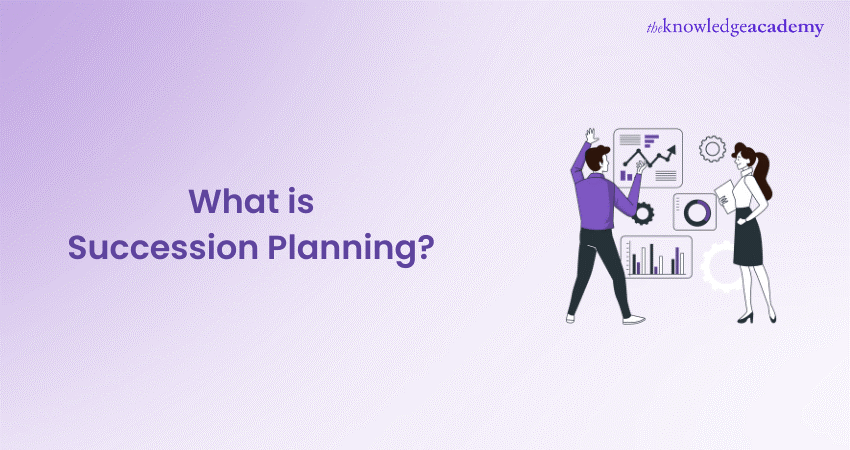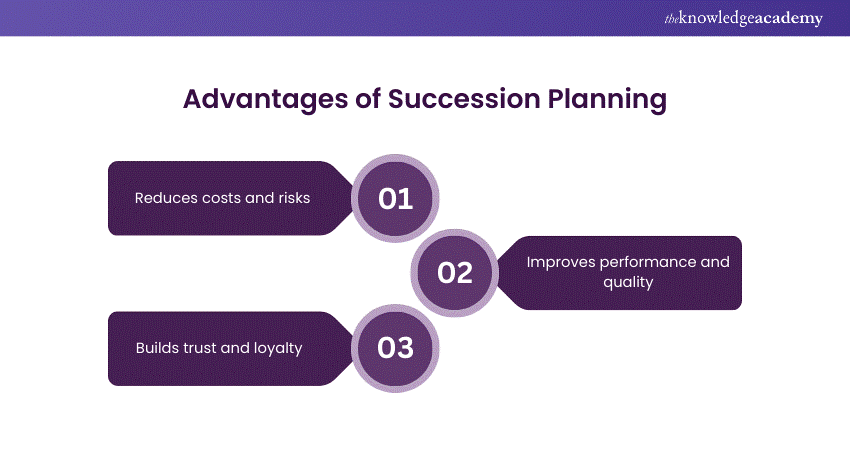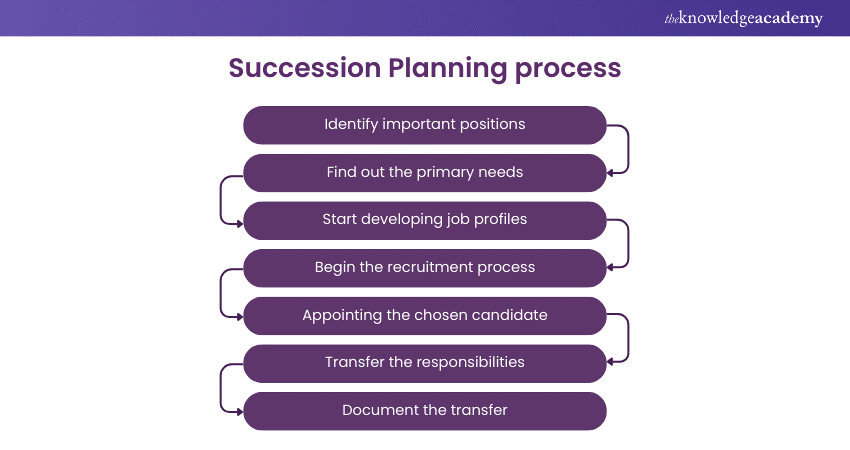We may not have the course you’re looking for. If you enquire or give us a call on +852 2592 5349 and speak to our training experts, we may still be able to help with your training requirements.
Training Outcomes Within Your Budget!
We ensure quality, budget-alignment, and timely delivery by our expert instructors.

Do you want to ensure the future success and sustainability of your organisation? If yes, then you need to know What is Succession Planning. A Succession Plan is identifying and developing future leaders for your organisation. In this blog, you will learn everything you need to know about What is Succession Planning, from its benefits, challenges, and best practices. So, delve in to learn more!
Table of Contents
1) What is Succession Planning?
2) Advantages of Succession Planning
3) Succession Planning and diversity
4) Succession Planning process
5) Examples of Succession Planning6) Effective strategies for Succession Planning
7) Conclusion
What is Succession Planning?
Succession Planning is the systematic and strategic process of identifying, assessing, and developing potential successors for critical positions in an organisation. This approach also helps in ensuring that businesses continue to run efficiently without any interruption, even after the major people leave the organisation, retire or new opportunities. It also involves the replacement of current leaders while simultaneously fostering a culture that prioritises leadership development and effective Talent Management. It alignsthe organisation’s vision, goals, and values with its employees' skills, competencies, and aspirations. It also requires fostering a learning environment that encourages continuous feedback, coaching, and mentoring.

Advantages of Succession Planning
Now that you know What is Succession Planning, let’s learn about its advantages. Some of the advantages of Succession Planning are:

a) Reduces costs and risks: Succession Planning helps reduce the costs and risks associated with hiring, training, and integrating external candidates for key positions. It also helps to prevent the loss of valuable knowledge, skills, and relationships that may occur when the current incumbents leave the organisation.
b) Improves performance and quality: It ensures that the most suitable candidates fill the key positions with the required skills, competencies, and experience. It also helps maintain and enhance the organisation's and its stakeholders' standards and expectations.
c) Builds trust and loyalty: Succession Planning helps build trust and loyalty by demonstrating the organisation’s commitment and care for its people and future. It also helps to create a positive and supportive work environment that fosters collaboration and teamwork.
Elevate your Project Management expertise to a global level with our Certified Global Project Manager (CGPM) Course - sign up today!
Succession Planning and diversity
Succession Planning helps introduce diversity in the workplace. It brings a significant change in the organisation so that they meet their Diversity, Equity, Inclusion, and Belonging (DEI&B) goals. With the help of Succession Planning, organisations can push beyond their boundaries and allow people belonging to different backgrounds to take on more responsibility as they ascend to higher positions. This helps in maintaining equity throughout all the levels of the organisation.
Succession Planning process
There are seven major steps that goes into Succession Planning. Let’s discuss these seven steps:

1) Identify important positions
If you or your organisation is beginning to plan the succession, you must reflect on why and how you want to do it. You can take the first step by identifying the primary qualifications of your employees that are crucial to your organisation goals and success. Some of these qualifications can include their years of experience, their educational background, and most importantly the soft skills which will make a big impact on your company’s success.
2) Find out the primary needs
Only knowing the background is not enough. You need to look within your organisation and identify areas which needs attention first. You must make note which employees are leaving the organisation, number of employees who are retiring, etc.
You must also look from the top to the bottom of your organisation. Beginning from the leadership to further down the organisational pyramid. In this second step, it is crucial that you include all the financial resources that you may require for completing the recruiting process. Try to notice the software that are being used in the recruitment process. It is because a good software not only saves resources but also time.
3) Start developing job profiles
An important part of developing a Succession Plan is creating the job profiles for the successors. Start by what are the tasks, qualifications, evolutions, and additions that are required, which will make the process of Succession Planning smooth. Remember this template can be important in finding the right person for the position. Most importantly this helps the current employee to turn their skills into actionable plan.
4) Begin the recruitment process
Succession Planning truly begins when the recruitment process begins. At this point, slowly the process starts to take its shape which helps in building your talent pool. You can also see the employee referral programs coming into light as the recruitment drive begins.
This also encourages your current employees to invest their time in upskilling themselves. However, remember, these will come to fruition only if you take a proactive approach. You can also fasten the Succession process by keeping a deadline on the completion of the recruitment process.
5) Appointing the chosen candidate
Once the recruitment process comes to an end, you will have the right candidate waiting to be appointed. Candidates that you choose might not fulfil the technical requirements of organisation, but they can be a good fit, culturally. Only after this candidate goes through assessment tests and work trials, they can prove to be the best fit for the company. This can take place in the appointment phase, where the candidate can spend time with other employees or the management. This will show them how they mesh with the organisation.
6) Transfer the responsibilities
Before you transfer the responsibilities to the candidate, learn how well they fit in casual situations, so that you get to know their personality. After that, you can hand over the responsibilities so that it does not overwhelm them and help them process slowly.
Moreover, create a schedule where you handle the duties one by one, instead of rushing into it. Especially if it is for a leadership position, this handing over responsibilities can take a long time from a few weeks to few months.
However, there is also a risk that persists. If the successor takes more time than was originally planned, they may grow accustomed to the old ways the department used to run. Thus, they will not be able to focus on developing new skills and new processes to keep the organisation from slipping to outdated process. Therefore, this step should be carried out in such a way that enough time is allocated for them and at the same time fast-paced and collaborative approach is taken to handle over the knowledge.
7) Document the transfer
You must document how the Succession Planning process was carried out. This is a crucial step, as it helps in building accountability and provides a framework for any future Succession Planning.
You must document how much was the demand of the position that required succession, the processes that were utilised to achieve that, any issues or problems that may have surfaced during the process, how did you recover from it, and the potential gaps that may exist in the organisation or in the process.
Examples of Succession Planning
If you want to know how does Succession Planning look like in reality, here are two examples:
1) Example 1: McCormick & Co
In the year 2008, McCormick & Co carefully transitioned Alan Wilson in place of their CEO Robert Lawless. They used a carefully planned a Succession Process which was spread over a period of five years. This helped in the easy transition of a non-executive chairman to a board role. In this Succession plan, the areas were carefully identified and developed so that it fit their senior executives. They also continuously monitored the progress the Mr. Wilson, over the years who had a strong alignment with their company culture and understanding major issues.
2) Example 2: Barneys New York
In 2017, Daniella Vitale replaced Mark Lee in Barneys. Vitale had a good experience in the fashion industry and had significant experience in the same. She was presented with a lot of opportunities, which involved running almost every facet of the organisation. This, along with a good mentorship from Lee, helped her in the leadership position. Her Succession Planning process was also spread over a period of five years which helped her develop the necessary skills that would be required, to run the organisation.
Effective strategies for Succession Planning
Succession Planning can be challenging and complex, involving multiple factors, stakeholders, and uncertainties. However, some effective strategies can help make the succession planning process more efficient and successful. Some of these strategies are:
Embrace a long-term outlook
Succession Planning should not be seen as a one-time or short-term activity but rather as a continuous and long-term process. The organisation should clearly understand its current and future needs, strengths, and weaknesses. It should also anticipate and prepare for any changes or disruptions affecting its operations or goals
Ensure structured development
Succession Planning should not be based on assumptions or intuitions but rather on structured and systematic development of the potential successors. The organisation should have well-defined and transparent criteria and processes for identifying, assessing, and developing potential successors. It should also provide them with consistent and constructive feedback, recognition, and support.
Integrate Succession Planning with Talent Management
The organisation should have a holistic and comprehensive approach to managing its human capital from the processes given below:
a) Attracting
b) Recruiting
c) Retaining
d) Developing
e) Engaging
f) Rewarding
It should also leverage its existing tools and resources, such as performance management, learning management, and talent analytics, to facilitate and enhance the Succession Planning process.
Be realistic and communicate clearly
Succession Planning should not be unrealistic or ambiguous but rather realistic and clear. The organisation should have realistic and attainable expectations and goals for the Succession Planning process, as well as for the potential successors and the key positions. It should also communicate clearly and openly with all about the purpose, process, and outcomes of succession planning.
Evaluate results, not just procedures
Succession Planning should not be focused on the procedures or activities but rather on the results or outcomes. It should use feedback and data to review and update the Succession Plan and identify and address any gaps or challenges.
Conclusion
We hope that from this blog you have understood the key concepts of What is Succession Planning. This blog also discussed that it involves preparing future leaders for their roles and enhancing their abilities, attitudes, and compatibility. It considers the whole picture of the person, the group, and the company. Hope you now have a clear picture on What is Succession Planning.
Elevate your Project Management expertise with a diverse range of Project Management Courses tailored to enhance skills and drive successful project outcomes. Join now!
Frequently Asked Questions

Succession Planning ensures a seamless transition in key roles. This process prepares employees for advancement, fostering professional growth and career progression. It creates a talent pipeline, enhancing organisational stability and employee morale by clearly mapping out career paths and providing development opportunities.

These are some of the best practices for identifying and nurturing future leaders:
a) Establishing clear criteria
b) Using performance metrics
c) Using potential personality assessments
d) Implementing mentorship and coaching programs
e) Offering regular feedback.

The Knowledge Academy takes global learning to new heights, offering over 30,000 online courses across 490+ locations in 220 countries. This expansive reach ensures accessibility and convenience for learners worldwide.
Alongside our diverse Online Course Catalogue, encompassing 17 major categories, we go the extra mile by providing a plethora of free educational Online Resources like News updates, Blogs, videos, webinars, and interview questions. Tailoring learning experiences further, professionals can maximise value with customisable Course Bundles of TKA.

The Knowledge Academy’s Knowledge Pass, a prepaid voucher, adds another layer of flexibility, allowing course bookings over a 12-month period. Join us on a journey where education knows no bounds.

The Knowledge Academy offers various Project Management Courses, including Certified Global Project Manager (CGPM), Project Management Black Belt etc. These courses cater to different skill levels, providing comprehensive insights into Project Management methodologies.
Our Project Management blogs covers a range of topics related to Certified Global Project Manager (CGPM), offering valuable resources, best practices, and industry insights. Whether you are a beginner or looking to advance your Project Management skills, The Knowledge Academy's diverse courses and informative blogs have you covered.

The Knowledge Academy’s FlexiPass is a pre-paid training voucher that is built specifically for clients and their dynamic needs. It provides access to a wide range of courses at a pre-determined price, with robust safety measures. FlexiPass gives clients the added benefit of upskilling on a budget that best fits them.
Upcoming Project Management Resources Batches & Dates
Date
 Introduction to Project Management Course
Introduction to Project Management Course
Fri 17th Jan 2025
Fri 7th Mar 2025
Fri 23rd May 2025
Fri 12th Sep 2025
Fri 14th Nov 2025
Fri 12th Dec 2025







 Top Rated Course
Top Rated Course


 If you wish to make any changes to your course, please
If you wish to make any changes to your course, please


